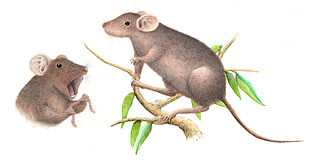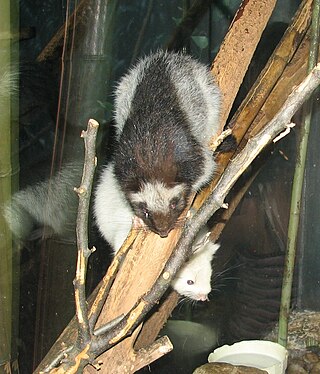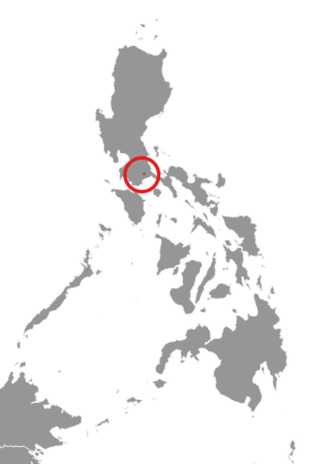
The Old World rats and mice, part of the subfamily Murinae in the family Muridae, comprise at least 519 species. Members of this subfamily are called murines. In terms of species richness, this subfamily is larger than all mammal families except the Cricetidae and Muridae, and is larger than all mammal orders except the bats and the remainder of the rodents.

The genus Chrotomys contain a unique group of rodents found only in the Philippines, specifically the islands of Luzon, Mindoro, and Sibuyan. Instead of being predominantly herbivorous or omnivorous like other murines, these rats feed predominantly on invertebrates although they do eat some vegetable matter. This vermivory is probably the result of a rat-like animal moving into an ecological niche usually filled by shrews. Shrews and other insectivores are absent on these Philippine islands.

Apomys, commonly known as earthworm mice, is a genus of rodent endemic to the Philippines. Mice belonging to this genus are generally called Philippine forest mice and can be found on most islands of the Philippines except in Palawan, the Sulu Archipelago, and the Batanes and Babuyan group of islands.

Batomys is a genus of rodent endemic to the Philippines. It has six extant described species.

The cloud rats or cloudrunners are a tribe (Phloeomyini) of arboreal and nocturnal herbivorous rodents endemic to the cloud forests of the Philippines. They belong to the family Muridae and include five genera: Batomys, Carpomys, Crateromys, Musseromys, and Phloeomys. They range in size from as large as 50 cm (20 in) to as small as 74 mm (2.9 in). Cloud rats are threatened by habitat loss and illegal hunting. Several species are endangered or critically endangered.

Archboldomys, the shrew-mice, are a genus of rodents in the family Muridae. They are carnivores that feed on invertebrates much like shrews do. An apparently smaller relatives of the true shrew-rats Chrotomys and Rhynchomys, Archboldomys are somewhat convergent to the more distantly related Crunomys.

The Mount Data shrew-rat is a species of rodent in the family Muridae. It is found only in the Philippines.

The Katanglad shrew-mouse, also known as the Kitanglad shrew-mouse is a species of rodent in the family Muridae. It is known only from one specimen taken at 2250 m on Mount Kitanglad, Bukidnon Province, Philippines.

The Kalinga shrew mouse is a rodent of the genus Soricomys found in the northern province of Kalinga, island of Luzon, in the northern Philippines.
Musseromys is a genus of rodent, in the family Muridae, endemic to the Philippines. Four species are known, all from Luzon:

The Banahao shrew-rat is a species of rodent in the genus Rhynchomys. It was described in 2007.

The Tapulao shrew-rat is a rodent in the subfamily Murinae. It was described in 2007.

Sibuyan striped shrew-rat is a species of rodent in the family Muridae. The holotype was collected in 1992; however, it wasn't formally described until 2005.
Batomys uragon is a species of cloud rat endemic to the Philippines. It was first discovered in 1988, and the full description was published in 2015, in the Proceedings of the Biological Society of Washington. It is so far found only on Luzon, the largest island in the Philippines. The first specimen was collected from Mount Isarog at the southern side of the island. Other 14 specimens were later collected. It is the fourth species of mammal living only on that mountain. The new species was described by Danilo S. Balete, Eric A. Rickart, Lawrence R. Heaney, and Sharon A. Jansa. It was classified as new species based on DNA analyses and structural descriptions. It is different from its closest relative, the Luzon hairy-tailed rat, in its cytochrome b sequence, moderate body size, colour patterns, and skull structure.

Soricomys, the shrew-mice, are a genus of rodents in the family Muridae. They are carnivores that feed on invertebrates much like shrews do. An apparently smaller relatives of the true shrew-rats Chrotomys and Rhynchomys, Soricomys are somewhat convergent to the more distantly related Crunomys.
The Labo shrew rat is a species of shrewlike rat in the subfamily Murinae. It was discovered at elevations above 1250 m on Mt. Labo of the Bicol Peninsula of Luzon in the Philippines and described in 2019.
The Mingan shrew rat is a species of shrewlike rat in the subfamily Murinae. It was discovered at elevations above 1450 m on Mt. Mingan of the central Sierra Madre of Luzon in the Philippines and described in 2019.
Danilo S. Balete, also known as Danny Balete, was a Filipino zoologist and biologist. His is known for his work on the Philippines' endemic mammal species. He pursued the question of what determines species diversity. The research by Balete and his team overturned previously held notions that diversity decreased in mountainous regions, showing that harsh environments could generate, rather than suppress, species diversity.
The large Cordillera shrew-mouse is a species of rodent in the family Muridae found only in the Philippines.
Co's shrew mouse is a rodent of the genus Soricomys found on the island of Luzon, in the northern Philippines.












